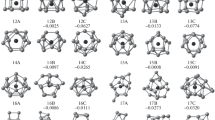Abstract
This paper presents spatial structure optimization results and calculated electronic spectra for ZrGe − n (n = 8–20) anion clusters. Comparison of density-functional calculation results and available experimental data allows us to identify real spatial structures of the clusters. The formation of stable endohedral ZrGe − n clusters is possible for n ≥ 12. The clusters with a smaller number of germanium atoms predominantly have exohedral structures.
Similar content being viewed by others
References
Kroto, H.W., Heath, J.R., O’Brien, S.C., Curl, R.F., and Smalley, R.E., C60: buckminsterfullerene, Nature (London), 1985, vol. 318, pp. 162–163.
Ma, S. and Wang, C., Structures of medium size germanium clusters, J. Mol. Struct.: THEOCHEM, 2006, vol. 767, pp. 75–79.
Shvartsburg, A.A., Bei Liu, Zhong-Yi Lu, Cai-Zhuang Wang, Jarrold, M.F., and Kai-Ming Ho, Structures of germanium clusters: where the growth patterns of silicon and germanium clusters diverge, Phys. Rev. Lett., 1999, vol. 83, pp. 2167–2170.
Kumar, V. and Kawazoe, Y., Metal-encapsulated caged clusters of germanium with large gaps and different growth behavior than silicon, Phys. Rev. Lett., 2002, vol. 88, pp. 235504–235507.
Lu, J. and Nagase, S., Metal-doped germanium clusters MGens at the sizes of n = 12 and 10: divergence of growth patterns from the MSin clusters, Chem. Phys. Lett., 2003, vol. 372, pp. 394–398.
Wang, J. and Han Ju-Guang, Geometries and electronic properties of the tungsten-doped germanium clusters: WGen (n = 1–17), J. Phys. Chem. A, 2006, vol. 110, pp. 12670–12677.
Wang, J. and Han Ju-Guang, Geometries, stabilities, and vibrational properties of bimetallic Mo2-doped Gen (n = 9–15) clusters: a density functional investigation, J. Phys. Chem. A, 2008, vol. 112, pp. 3224–3230.
Xin-Juan Hou, Gopakumar, G., Lievens, P., and Minh Tho Nguyen, Chromium-doped germanium clusters CrGen (n = 1–5): geometry, electronic structure, and topology of chemical bonding, J. Phys. Chem. A, 2007, vol. 111, pp. 13544–13553.
Atobe, J., Koyasu, K., Furuse, S., and Nakajima, A., Anion photoelectron spectroscopy of germanium and tin clusters containing a transition-or lanthanide-metal atom; ZrGe- n (n = 8–20) and MSn- n (n = 15–17) (M = Sc–V, Y–Nb, and Lu–Ta), Phys. Chem. Chem. Phys., 2012, vol. 14, pp. 9403–9410.
Lee, C., Yang, W., and Parr, R.G., Development of the Colle–Salvetti conelation energy formula into a functional of the electron density, Phys. Rev. B: Condens. Matter Mater. Phys., 1988, vol. 37, pp. 785–789.
Wachters, A.J.H., Gaussian basis set for molecular wavefunctions containing third-row atoms, J. Chem. Phys., 1970, vol. 52, pp. 1033–1036.
Godbout, N., Salahub, D.R., Andzelm, J., and Wimmer, E., Optimization of Gaussian-type basis sets for local spin density functional calculations. Part I. Boron through neon, optimization technique and validation, Can. J. Chem., 1992, vol. 70, pp. 560–571.
Godfrey, S.M. and Hinchliffe, A., Density functional studies on the reagents Me3PX2 (where X = F, Cl, Br and I) in the gas phase and in solution, J. Mol. Struct.: THEOCHEM, 2006, vol. 761, pp. 1–5.
Frisch, M.J. et al., Gaussian 03. Revision B03, Pittsburg: Gaussian Inc., 2003.
Reveles, J.U. and Khanna, S.N., Electronic counting rules for the stability of metal–silicon clusters, Phys. Rev. B: Condens. Matter Mater. Phys., 2006, vol. 74, no. 3, paper 035435.
Author information
Authors and Affiliations
Corresponding author
Additional information
Original Russian Text © N.A. Borshch, S.I. Kurganskii, 2018, published in Neorganicheskie Materialy, 2018, Vol. 54, No. 1, pp. 3–10.
Rights and permissions
About this article
Cite this article
Borshch, N.A., Kurganskii, S.I. Atomic Structure and Electronic Properties of Anionic Germanium–Zirconium Clusters. Inorg Mater 54, 1–7 (2018). https://doi.org/10.1134/S0020168518010028
Received:
Published:
Issue Date:
DOI: https://doi.org/10.1134/S0020168518010028



